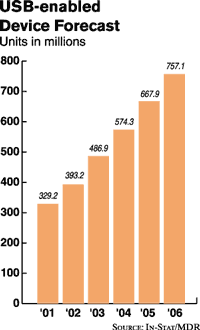PCs, Peripherals
and Consumer Electronics
Getting on the Universal Serial Bus
SCOTTSDALE, Ariz., February 26,
2003 - With Universal Serial Bus (USB) 2.0 succeeding the
first generation USB standard, USB saw continued success in 2002,
according to In-Stat/MDR. The high-tech market research firm reports that
in 2002, PC manufacturers adopted the new standard very quickly; to the
extent that all desktop PCs shipped by the end of 2003 will be USB
2.0-enabled. As the standard is adopted by notebook PCs and, eventually,
PC peripherals and consumer electronics devices, the total number of
USB-enabled devices will increase from approximately 375 million in 2002
to 863 million in 2007, a CAGR of 18.2%. The report, USB:
PCs, Peripherals & Consumer Electronics Get On the Bus (#IN030579MI),
contains five-year forecasts for USB 1.x, USB 2.0 and USB On-The-Go
penetration into 33 separate applications. Responses on USB from In-Stat/MDR’s
annual Residential Technology Survey are included in the report. Brief
profiles of major USB silicon and IP suppliers are also provided.

In-Stat/MDR has also found that:

 The
original USB 1.0 standard, with a maximum data rate of 1.5Mbits/sec.,
was released in 1996. The USB 1.1 standard followed, with a maximum data
rate of 12Mbits/sec. and backward compatibility with USB 1.0, opening
the market for peripherals and consumer electronic products that
required higher throughput.
The
original USB 1.0 standard, with a maximum data rate of 1.5Mbits/sec.,
was released in 1996. The USB 1.1 standard followed, with a maximum data
rate of 12Mbits/sec. and backward compatibility with USB 1.0, opening
the market for peripherals and consumer electronic products that
required higher throughput.